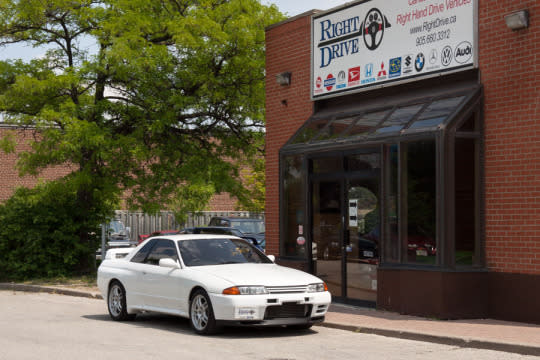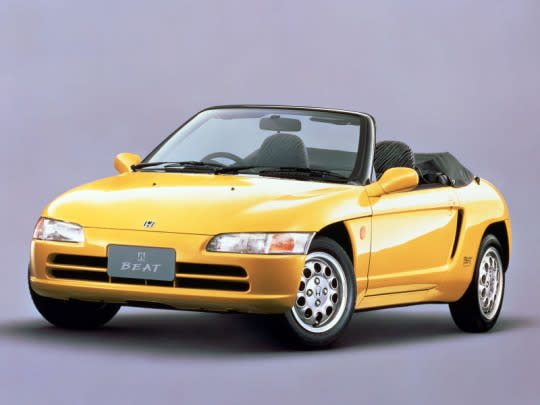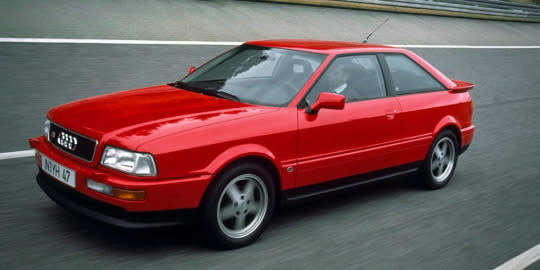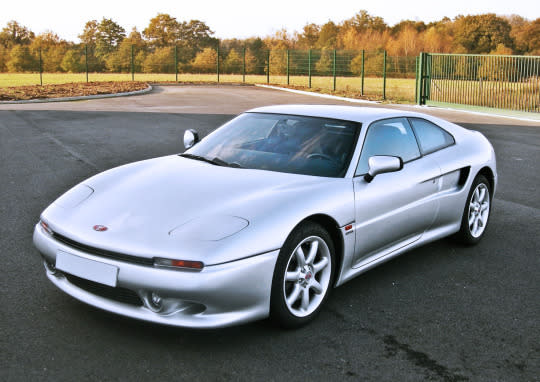9 Future Collector Cars Turning Legal For Import In 2016
As stories of crushed Skyline GT-Rs and Minis have shown, the U.S. government shows no mercy towards illegal grey-market imports. It’s why the 25-year threshold is a cherished milestone to collectors and enthusiasts—when the long-forbidden cars no longer need to adhere to federal safety standards.
The 25-year threshold is especially interesting now because it opens up cars made during the Japanese bubble era, a time when Japanese automakers prodigiously churned out performance cars in the midst of a stock and housing boom. Most of those cars never saw a release stateside, and since the majority of Japanese people nowadays have lost interest in old enthusiast cars, many are now available at reasonable prices.
But buying your dream grey-market car isn’t as simple as finding a ’91 model on Goo-net, and then shipping it in a container. Listen to Brian Jannusch, sales manager at International Vehicle Importers from Ontario, Calif, a company that sells grey-market cars and handles all the bureaucratic hurdles to make them compliant.
“A common misconception is that all 1991 cars are eligible for import at once,” said Jannusch. “For example, a car manufactured in June of 1991 is not eligible for import until June of 2016.”
There’s also a myriad of paperwork needed to bring the car in and register it in your state, including customs entry forms, DOT and EPA entry documents, which you can handle yourself or rely on a registered importer. “When beginning the search for a grey-market car we stress the importance of working with a reputable importer with a proven track record,” Jannusch says. “There are a lot of things that can go wrong if important details are overlooked which could cause your car to be refused entry to the U.S. or cause extensive delays.”
The same regulations also apply to cars from Canada, unless it’s a model identical to a model certified in the United States, where you can obtain a letter of compliance from the manufacturer.
Unfortunately for those of us who live in California, there’s the additional hurdle of making it CARB compliant. Jannusch recommends a car that’s “near stock and in 100 percent perfect running order,” which is then sent to a lab for further emissions modifications. “We have worked out a deal with the lab that does the work to give our customers a substantial discount. With a previous price tag of around $15,000 we can now offer compliance work to our customers for right around $10,000.”
One tip about importing from Japan–throw out your definition of “low mileage,” because cars there don’t get a lot of highway miles, especially if they’re from a metropolitan area. So that “cherry” 90,000-mile car from Tokyo might have racked up the miles those slogging through gridlocked Shinjuku traffic, getting heat soaked in sweltering summer weather with 90 percent humidity.
Still willing to take a plunge? Here are some collectible cars now legal for import for 2016, both from Japan and Europe. These cars have either lived theirs years in relative obscurity, or have only started to appreciate, making them relatively affordable.

Nissan Figaro
Nissan produced 20,000 of these chic, retro convertibles exclusively for the Japanese market, which could only be bought through a random lottery selection. Based on the B-segment March, it was powered by an anemic 75-horsepower 1-liter engine paired to a 3-speed automatic, but had a surprisingly upscale interior, with standard leather seats. Although there are a couple dozen examples for sale in Japan, prices have only started to appreciate to its original price of 1,870,000 yen (about $14,500 in 1991), and they now average at $8,000.

Photo: rightdriveusa.com
Nissan Skyline GT-R N1
Skyline GT-Rs saw prices skyrocket when the ’89 model became available for importation to the U.S., and what used to be $5000 budget tuner cars now command prices above $20,000. The Nismo version can exceed $50,000, and the quicker N1 is now available for import, likely with an even higher premium due to its rarity. A lightweight version akin to a Porsche RS, the GT-R N1 has no ABS, AC, or rear wipers and comes with upgraded cooling along with a slight power bump. Also, if you’re in the market for a regular GT-R, know that the mid-cycle-refresh model produced after August 1991 is over 120 pounds heavier, thanks to the added side impact beams.

Alpina B12 5.0
Although a V-12-powered BMW 8 Series can be had for the price of a stripped down Mitsubishi Mirage, the notoriously expensive maintenance costs keep casual enthusiasts away. For those that want a more exclusive money-pit, there’s the Alpina B12 5.0, based on the BMW 850i. The specs were underwhelming even back then—it was only available with a four-speed slushbox and went from zero to 62 in 6.8 seconds—but Alpina made only 97 of them, and the rarity coupled with its beauty mean they can only increase in value. One recently sold for $75,000.

Honda Beat
The ‘90s in Japan saw an influx of kei performance cars, starting with the Honda Beat in May of 1991. Nicknamed the “midship amusement,” the Beat was mid-engine rear-wheel drive like the NSX, with MacPherson struts at all four corners and a monocoque body. Although it made 63 horsepower, it weighed only 1675 pounds and redlined at 8500 rpm. The best part of the Beat? It came with period-appropriate tiger-striped seats—perfect for that white Miami-Vice jacket gathering dust in your closet.

Suzuki Cappuccino
The lightest of the kei performance cars form the ‘90s, the front-engine, rear-wheel drive Cappucino weighed 1598 pounds and had a near-even 51 percent front and 49 percent rear weight distribution. Power came from a turbo three-cylinder that made 63 horsepower, with an available 5-speed manual or 3-speed automatic. The best version came in 1995, which used an all aluminum engine and weighed 20 pounds less—so you might be better off waiting a couple years.

Audi S2
As the successor to the Audi Quattro and the first model to wear the S badge, the S2 had a lot to live up to—and the mixed reception toward its softer, more refined driving may have contributed to the coupe never seeing a release in the U.S. Initially released with a 217-horsepower, 2.2-liter turbo and five speed, the S2 was refreshed in October 1992 with a 227-horsepower engine paired with a six-speed manual, and had overboost for a spurt of extra power.

Photo: The Car Spy | Flickr
TVR Griffith
Gamers growing up on Gran Turismo will likely remember this striking front-engine, rear-wheel drive roadster, which sold in small numbers along with the Chimaera. It’s British, so expect that debonair style to come with chronic oil leaks from the 240-horsepower Rover V8. The Griffith is quick though even if you opt for the 4.0, considering the Griffith weighed only 2300 pounds, and the roadster could sprint from zero to 60 in under five seconds. Although prices significantly vary, like old German luxury cars it’s best to buy well-kept examples—saving you from the heartache of an engine-out camshaft replacement.

Venturi Atlantique
A supercar so obscure that most French won’t recognize it’s from their own country, the Atlantique was a mid-engine rear-wheel drive two-seater that sold poorly in spite of its reputation as a quick but luxurious drive. Powered by a peaky 260-horsepower V6 turbo sourced from Renault, it had the performance to compete with the Lotus Esprit, but prospective buyers couldn’t get past its price tag, which started at around $90,000.

Photo: Chris Nielsen | Flickr
Nissan Pulsar GTI-R
The quickest hot hatch from the ‘90s that you’ve never heard of, the Pulsar GTI-R was created by Nissan as a homologation model for the WRC in 1991. Powered by the venerable SR20DET, it put down 226 horsepower to all four wheels through an ATESSA AWD system that was the precursor to the GT-R’s, and hit zero to 60 in under six seconds. Unfortunately, Nissan’s rally-racing aspirations for the GTI-R were short-lived, and the car experienced cooling issues from the cramped engine bay. Costing about $20,000 back in 1991, they’re still unknown commodity today, selling for about $10 grand in Japan.
This is by no means an exhaustive list—for the well-heeled there’s the near-unobtainable Porsche 964 Carrera 4 RS Lightweight that sells for over a quarter million, while enthusiasts on a more sensible budget might look towards a thoroughly depreciated Toyota Soarer (Lexus SC) for its 280-horsepower 1GZ-JTE engine. And those lamenting the death of the Lancer Evolution can rejoice–the first-gen Subaru WRX and Mitsubishi Lancer Evolution becoming available for import next year–so grey-market imports will be a boon to enthusiasts for years to come.

 Yahoo Autos
Yahoo Autos 